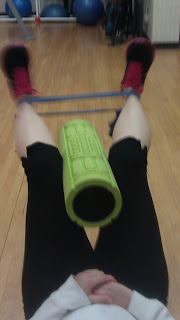Almost everyone who approaches me for personal training has the primary goal of losing weight or improving their physique. But almost inevitably, every person I train has moderate to severe muscular imbalances that impair their ability to reach their desired goals. Before I can progress them to a level of training that will yield a desired outcome, it is imperative that their bodies are properly aligned and balanced. Otherwise, injury is almost inevitable!
For example, if you perform a deep barbell squat, but your pelvis is crooked and your feet are externally rotated and your knees are falling inward and you are leaning too far forward, then you are causing injury and stress on your body's kinetic chain, (The combination and interrelation of the nervous, muscular, and skeletal systems) which will lead to pain and tension and inflammation....NOT a tight high booty and long lean legs.
SO, if you ever seek out a trainer...make sure that
#1. They are CERTIFIED. and
#2 that they are not pushing you beyond a physical limit your body can handle just to make you feel like you are burning lots of calories and getting your money's worth.
This is deceptive.
Meet with a trainer who will train you SMART before they train you hard.
I learned this valuable lesson for myself through a trainer I really respect. He helped me learn to relieve my upper back pain by strengthening my back muscles and stretching my chest muscles. I was so strong and tight on the front of my body that it was pulling everything forward and causing pain in the back of my body. Since training my back regularly, I am pain free, my posture is better, and my back is more defined muscularly.
Triple Threat! ;)
I have a dear and wonderful client who I have been working with regularly. Her hip is severely externally rotated on one side of her body. Because of this, she has trouble performing any exercises that rely on any type of lower body stability. It's hard for her to even do a plank on her toes because of her lower body imbalance...NOT for lack of upper body and core strength. My clients and I often have to go back to square one just to make certain that they are staying posturally aligned before advancing them to the next level of training.
IMBALANCE LEADS TO IMPAIRMENT
SYMMETRY LEADS TO STRENGTH
____________________________________________________________________________________
Here is a before and after picture of the difference a few corrective exercises did to internally rotate my client's hip prior to her training session.
BEFORE CORRECTIVE EXERCISE TRAINING
look at the asymmetry in her feet. this is indicative of her hip imbalance
AFTER CORRECTIVE EXERCISE TRAINING
Balance and symmetry!
Ready to WEIGHT TRAIN
As you can see in the before picture, her foot on the right is severely limited in it's range of motion because her inner thigh muscles are weak and the opposing muscles in her outer thigh and glutes are too tight. When she is standing, her right foot turns out. If she strength trains with this imbalance she will only perpetuate the problem.
SO what's the solution? We have to internally rotate her hip in order to create symmetry on both sides of her body by performing a few corrective exercises prior to training.
Below are a few of the exercises we performed which resulted in the symmetry you see in the after picture.
The exercises you see pictured, help to strengthen her inner thighs and internally rotate her hips.
______________________________________________________________________________________
Whether you have a trainer that you can work with or not, it is important that you are maintaining symmetry and balance in your form and posture as you train. When you go to the gym with a weight training plan, please make sure that you research the proper form and alignment required to execute your designated exercises properly.
There are different assessments that you can perform on yourself to determine the strengths and weaknesses in your kinetic chain. They will tell you which muscles are weak and which are too tight. As a result, you can determine which muscles you need to strengthen and which muscles you need to stretch. Incorporating the appropriate corrective exercises into your training routine will be well worth your while as it will allow you to correct your posture, relieve your pain, and prevent injuries that may otherwise inhibit you from getting the tight and strong body you are ultimately after. ;)
Here is a great video that will help you determine your areas of strength and weaknesses.
And here is a link to a free download of corrective exercise charts.
I have loved this site as a guide to help me with my clients!






